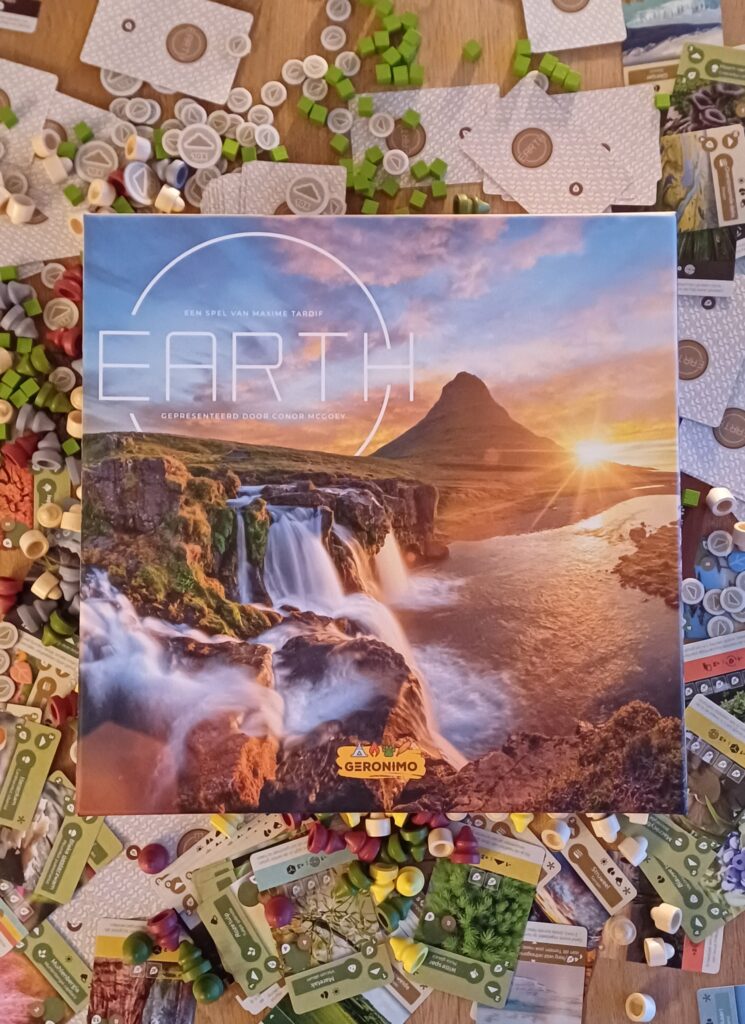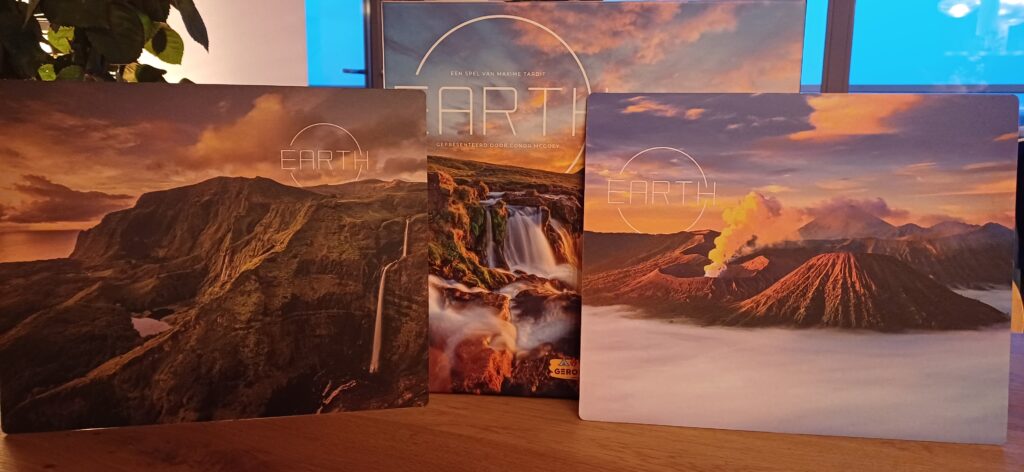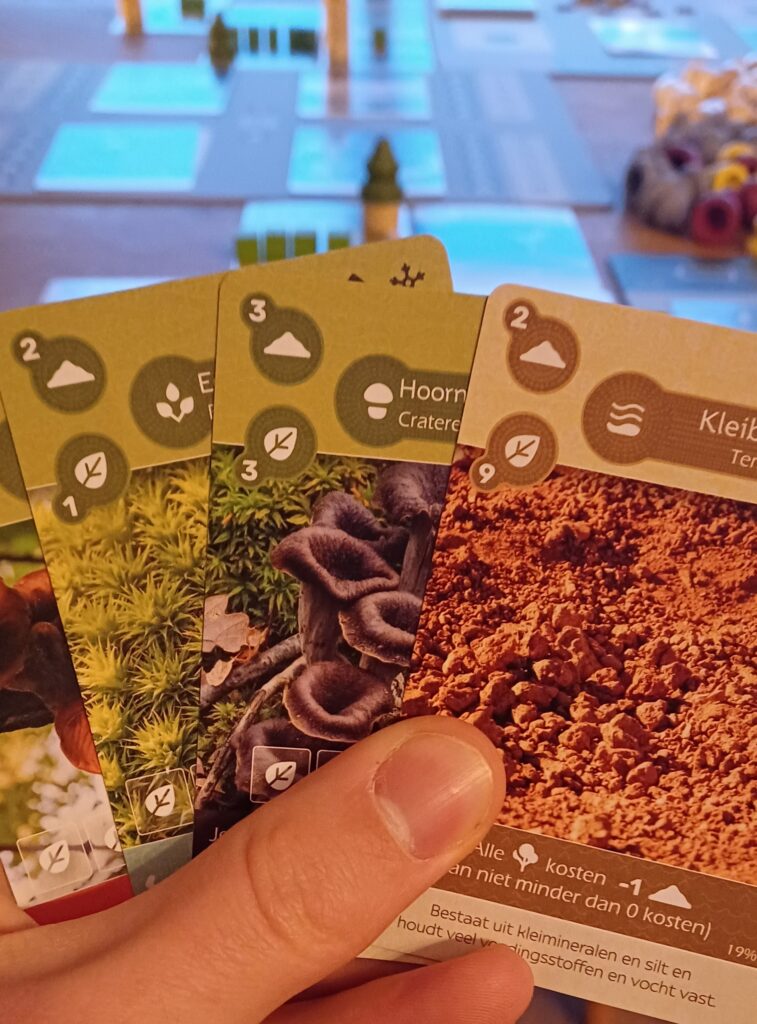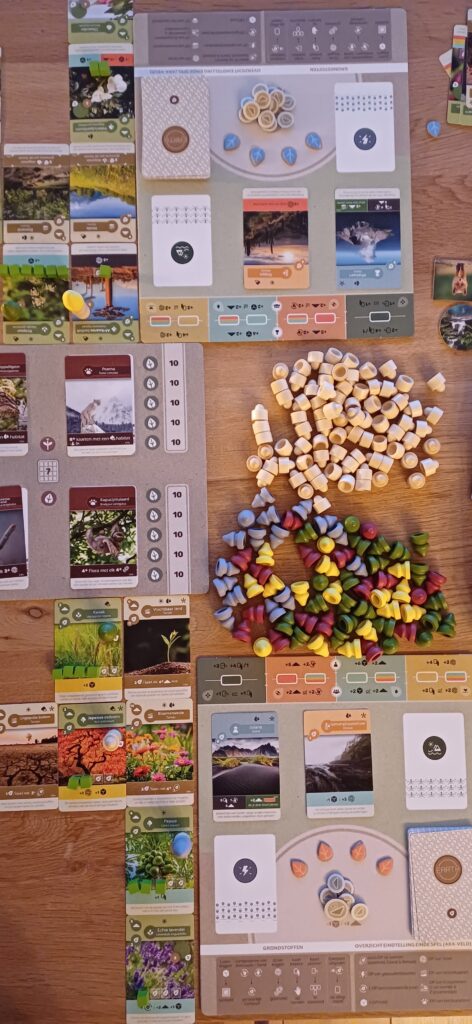If you have always wanted to create your own little piece of earth, Earth (the board game) will certainly not disappoint. Plants, landscapes, animals, mushrooms, islands, climates and various natural phenomena all pass by. Each player starts with his own game board and the fauna board is placed in the middle of the table. Then the general supply is laid out, consisting of: lots, ground tiles, trunks and canopies. Four fauna cards and two ecosystem cards must be placed on the fauna board. Finally, each player receives one ecosystem card, one island card, one climate card and five leaf tiles (four for their own game board). The cards just obtained are double-sided, so players have to choose which side they want to use.

The aim of the game is to collect as many points as possible by ‘planting’ the right combinations of earth cards in your own playing field in a grid of sixteen earth cards (four by four). When a player plants his or her sixteenth earth card, the game ends at the end of the round (and that player gets seven bonus points).
Then, of course, the question is: how do you carry out those actions? First, everyone gets the number of earth cards depicted on the island card. This also states that a number of earth cards must go immediately to the compost pile and how much earth the player gets. A bit more to the right of the island card, it shows a special characteristic. Secondly, the active player can perform one of the four actions at the top of the board. Note: the moment you choose an action, the other players also get that action, but in a toned-down form.


The possible actions are successively:
- Planting: the active player plants a maximum of two earth cards by paying the earth cost, takes four new earth cards and chooses one of them. The other players may plant one earth card and take one earth card (and keep it of course, otherwise it would have been very sour). The earth cost is shown on the top left of an earth card. The colours on the (planted) earth cards correspond to the colours of the four possible actions through which interesting bonuses can be earned. So after planting an earth card with a green bonus, that green bonus may be executed immediately. Planting must be adjacent, where diagonal is also allowed.
- Composting: the active player receives five earth and two earth cards, which go immediately to the compost pile. The other players may choose: two earth or two earth cards to the compost pile. Each compost card is worth one point at the end.
- Watering: the active player receives six lots and two earth. The other players can choose: two lots or two earth. The player places the lots on the available spots (being the squares with a leaf on them) on already planted earth cards. Logical follow-up question: what can you do with them? At any time, a player may choose to exchange three lots for two earth, but beware: at the end of the game, each lot is worth one point. So don’t exchange this ‘green gold’ too quickly!
- Grow: the active player receives four earth cards and two grow fiches. The other players may choose: two earth cards or two growth sheets. Some earth cards (obviously often plants), can grow and are eventually worth points (with foliage = an extra point).
I have just dropped how the actions work and how points can be scored while doing them, but that is not all. Points can also be scored in other ways. With your own ecosystem card, only you can score points, but with the two ecosystem cards on the fauna board, anyone can score points. The moment a player meets one of the four fauna cards on the fauna board, that player immediately scores points. If that player is first, then fifteen points are earned. The number of points to be earned then decreases to 11, 8, 6 and 5. The leaf tokens are used to indicate how many points the player has earned. Don’t forget that each player has a climate card, which also has a colour corresponding to a possible action. If you perform an action that corresponds to the colour of another player’s climate card, you are helping them.


Finally, the earth cards depicting an event. These cards can also be played throughout the game and do not have to be placed within the four-by-four grid. After playing, however, they do disappear on your game board and yield minus points at the end of the game.
Earth is essentially very similar to the popular board game Wingspan, which I can really enjoy. Therefore, Earth is also a really fun game for me. Still, Wingspan’s theme appeals to me just a little bit more. I’m more of a fauna type, rather than a flora type shall we say. That said, I don’t see any major drawbacks or lesser points in Earth, though I have to say that should you be someone who hates playing for yourself, Earth might not be quite your cup of tea. After all, there is little interaction between players, as you are really only concerned with your own world. The battle for the fauna board points and unintentionally helping other players by the colour of the climate card make that slightly different. Still, Earth is well put together and the box is great, with cool pictures of different landscapes, the box really comes to life.



